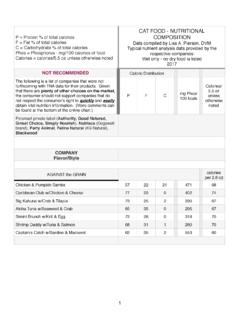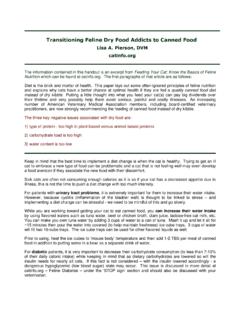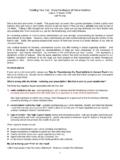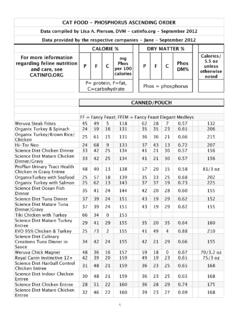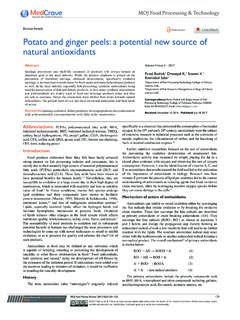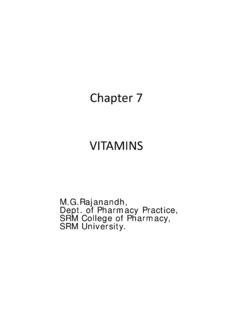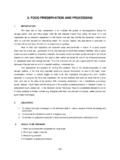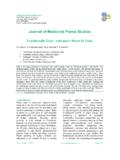Transcription of Timely Topics in Nutrition - catinfo.org
1 JAVMA, Vol 221, No. 11, December 1, 2002 Vet Med Today: Timely Topics in Nutrition1559 The carnivore connection to Nutrition in catsIn another time long ago, Leonardo da Vinci said, The smallest feline is a masterpiece. 1 And for thoseof us who marvel at the wonder that is a cat, there is nodoubt that his statement was remarkable for its sim-plicity as well as its truth. Cats are amazing creatures,unique and interesting in almost every way this, it has been common for veterinarians toconsider cats and dogs as similar beings for anesthesiaprotocols, clinical diseases, and treatments. However, itis quite clear that cats are unique in all conceivableways, particularly in their nutritional are strict carnivores that rely on nutrients in ani-mal tissues to meet their specific and unique Nutrition -al requirements.
2 This statement is news to few, yet theimportance of these nutritional differences is oftenunderestimated, especially during periods when catsare ill or have prolonged anorexia. In their naturalhabitat, cats consume prey high in protein with mod-erate amounts of fat and minimal amounts of carbohy-drate (CHO); thus, they are metabolically adapted forhigher metabolism of proteins and lower utilization ofCHOs (starch, not soluble or insoluble fiber) than dogsor other omnivores. Although cats can use CHOs as asource of metabolic energy, they have limited ability tospare protein utilization by using CHOs , commercial diets are formulated with amixture of animal- and plant-derived nutrients, mostcommonly in dry kibble form that requires CHOs forthe expansion and cooking process, to provide easy-to-use food for domestic cats.
3 And although cats haveadjusted to most manufactured diets, the limitations ofsubstituting animal-origin nutrients with plant-originnutrients in foods formulated for cats are beingincreasingly realized. The information reported here is an attempt todescribe what it means metabolically and nutritionallyto be a strict carnivore, with a focus on differences innutritional biochemistry of cats. In addition, informa-tion is included on possible roles of Nutrition in thedevelopment of obesity, idiopathic hepatic lipidosis(IHL), inflammatory bowel disease, and diabetes melli-tus in cats. ProteinThe natural diet of cats in the wild is a meat-basedregimen (eg, rodents, birds) that contains little CHO;thus, cats are metabolically adapted to preferentiallyuse protein and fat as energy sources (Appendix 1).
4 This evolutionary difference in energy metabolismmandates cats to use protein for maintenance of bloodglucose concentrations even when sources of proteinin the diet are substantial difference inprotein requirements between cats and omnivores,such as dogs, serves to illustrate this important meta-bolic distinction. For example, whereas the proteinrequirement of kittens is times that of the young ofother species, adult cats require 2 to 3 times more pro-tein in their diet than adults of omnivorous ,4 The fact that cats have such a greater dietary proteinrequirement, compared to dogs, necessitates that catsmust have a higher basal requirement for nitrogen(protein) or an increased requirement for essentialamino acids.
5 In the case of adult cats, the increasedprotein requirement is attributable to both; however,the requirement for essential amino acids in kittens issimilar to that of the young of other species,5so a high-er basal requirement for nitrogen is suggested to playthe largest role in kittens. Several possible reasons exist for the increasedneed for protein, but the fact that cats depend on pro-tein for energy as well as structural and synthetic pur-poses is a major component. When fed a low-proteindiet, most omnivores conserve amino acids by reduc-ing the activities of aminotransferases and otherenzymes involved in protein ,7 However, ina classic study,8cats were fed diets low (170 g/kg [77g/lb] of body weight) and high (700 g/kg [318 g/lb] ofbody weight) in protein to determine whether theyresponded to low-protein conditions in a manner sim-ilar to that of omnivorous species.
6 Regardless ofwhether cats were fed low or high amounts of dietaryprotein, there was little adaptation in the activities ofthe aminotransferases or urea cycle study,9it was suggested that cats have a limit-ed ability to adjust protein utilization to the amount ofprotein in their diets; however, the primary finding inthat study was that protein oxidation increased in catsTimely Topics in NutritionThe JAVMA welcomes contributions to this submitted for publication will be fully reviewedwith the American College of Veterinary Nutrition (ACVN)acting in an advisory capacity to the editors. Inquiriesshould be sent to Dr. John E. Bauer, Department of SmallAnimal Medicine and Surgery, College of VeterinaryMedicine, Texas A&M University, College Station, the Department of Small Animal Medicine and Surgery,College of Veterinary Medicine, Texas A&M University, CollegeStation, TX L.
7 Zoran, DVM, PhD, 11/6/2002 11:13 AM Page 15591560 Vet Med Today: Timely Topics in Nutrition JAVMA, Vol 221, No. 11, December 1, 2002fed high-protein diets. Protein oxidation did notdecrease in cats fed diets with moderate amounts ofprotein (low-protein diets were not evaluated).9 Nevertheless, those studies document that cats contin-ue to use protein (eg, dispensable nitrogen in the formof gluconeogenic amino acids) for production of ener-gy and in other metabolic pathways (eg, urea cycle),even in the face of low availability of proteins. Theseincreased protein requirements are an important rea-son why protein malnutrition can occur more quicklyin sick, injured, or anorectic addition to their increased need for dispensableprotein, cats also have need for increased amounts ofspecific amino acids in their diet: taurine, arginine,methionine, and specific amino acidrequirements of cats have likely been determined onthe basis that their natural diet contains an abundanceof each of these specific amino acids (in addition to 11essential amino acids; Appendix 2).
8 The likely reasonthat synthetic pathways for these amino acids, whichare found in omnivorous species, are not found in catsis that they are redundant and, thus, energy , even though cats do not have the abilityto synthesize these amino acids, the amino acids arenot conserved. In fact, utilization of these amino acids(taurine, arginine, methionine, and cysteine) is higherin cats than in dogs or other is a sulfur-containing amino acid that isnot incorporated into proteins or degraded by mam-malian tissues; however, it is essential for vision, car-diac muscle function, and proper function of the ner-vous, reproductive, and immune isessential in cats because they cannot synthesize ade-quate quantities from the typical precursors (ie,methionine or cysteine).
9 Enzymes required for synthe-sis of taurine (eg, cysteine dioxygenase and cysteinesulfinic acid decarboxylase) are only minimally activein , cats have a constant and obli-gate loss of taurine into bile, because they conjugatebile acids only with matters,the requirement for taurine in cats is influenced bymany factors including, but not limited to, the sourceof protein (ie, taurine is found in animal-source pro-teins but must be supplemented when plant-sourceproteins are used in the diet), commercial processing(heat processing reduces taurine bioavailability11), con-tent of sulfur-containing amino acids in the diet (tau-rine is synthesized from sulfur-containing amino acids[methionine and cysteine], although cats cannot meettheir needs via this pathway4), and amount of dietaryfiber (diets high in fiber increase the need for tau-rine12).
10 Prolonged (ie, a period of several months) defi-ciency of taurine is required before clinical signsappear in most cats. The most common signs of defi-ciency are blindness (central retinal degeneration),reproductive failure or neonatal loss, and developmentof dilated ,10 Diagnosis of taurine defi-ciency in cats is confirmed by measurement of taurineconcentrations in blood. Taurine concentrations in theblood reflect tissue taurine status better than do tau-rine concentrations in plasma, which can be affectedby release of cellular taurine (especially fromplatelets).2 The reference range for concentrations oftaurine in healthy cats is >300 nmol/mL, with con-centrations <160 nmol/mL consistent with is an essential amino acid in dogs andcats; however, in contrast to dogs, cats are unable tosynthesize sufficient amounts of ornithine or citrullinefor conversion to arginine.
